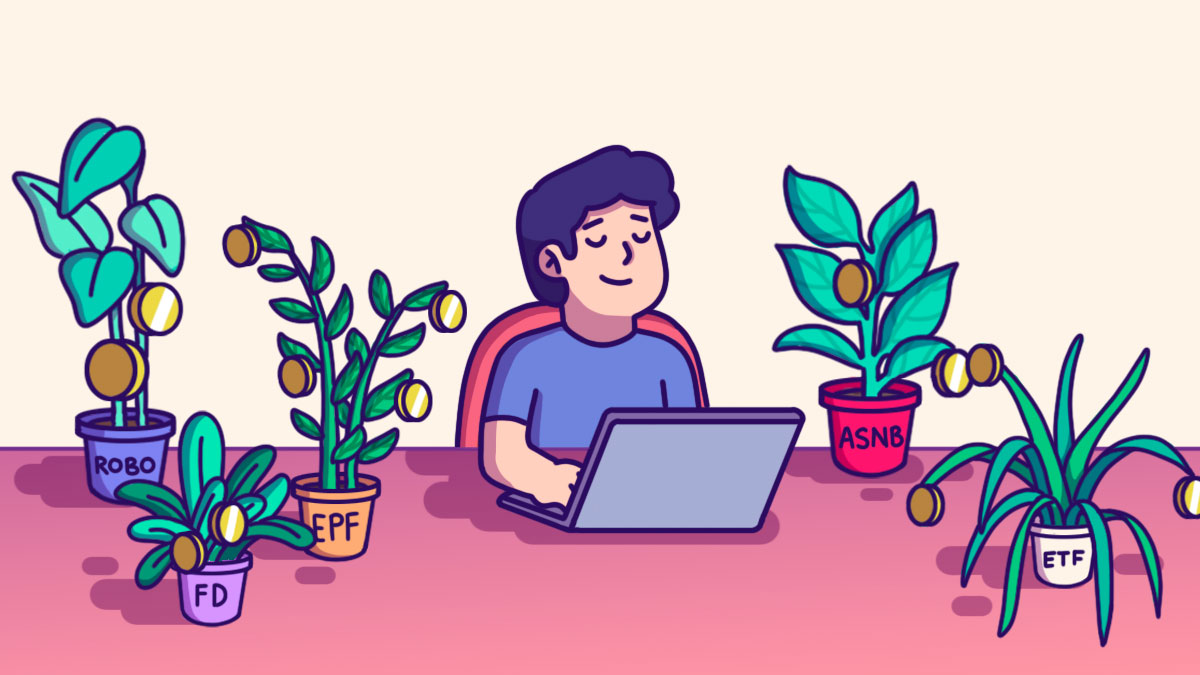Financial Planning | Investing | Personal Finance | Article
5 Low-Effort Ways Malaysians Can Grow Their Money
by The Simple Sum Team | 24 Feb 2022

There is a popular quote by Warren Buffett: “All there is to investing is picking good stocks at good times and staying with them as long as they remain good companies”.
But the problem is, that unlike Buffett, most of us don’t have the know-how to pick stocks. We also don’t have the time to mind the stock market to buy those stocks on the cheap.
Not to mention, many of us still don’t invest in stocks for fear of losing money. A survey published in CNBC revealed that 65% of American adults say they find investing in the stock market to be scary or intimidating.
So, does our lack of time, inability to pick stocks and aversion to losing money in the stock market prevent us from being able to grow our wealth over time? It should not.
Fortunately, investing in stocks isn’t the only way to grow your money.
There are a range of investment products that you can put your money into, especially if you are planning to grow your money over a long period of time.
While some investment products require more time and research and tend to come with more volatility and risk, there are others that don’t require much effort at all, and, in some cases, are less risky than picking individual stocks.
Here are five investment products in Malaysia that allows us to grow our money with minimal effort.
Related
Employee Provident Fund (EPF)
Most of us have an EPF account as a mandatory retirement savings plan implemented by the government. But aside from the 11% that is deducted from our pay cheques every month, did you know that you can also make voluntary contributions to boost your retirement savings?
There are two schemes you can apply for – self-contribution and i-Saraan. Self-contribution is for those who are employed and would like to increase their retirement savings. i-Saraan is for those who have irregular income, are self-employed, and for business owners who would like to have retirement savings.
To encourage the self-employed to contribute to their EPF savings, a government incentive is given to i-Saraan contributors.
For both schemes, you can place up to RM60,000 a year in your EPF savings. And like your regular EPF contribution, 70% of your additional contribution will go into Account 1 and the remaining 30% will go into Account 2.
These contributions can be made at any time and in a host of different ways: cash, bank draft, cheque and online banking.
Benefits
-
Consistent annual dividends
The average EPF conventional dividend rate for the past 10 years (2010 to 2020) is 6.11%. This beats inflation, which averages between 2% to 3%.
Legally, EPF is obligated to provide dividends of 2.5%, but since 2000, dividend rates have not fallen below 4.25%.
-
No risk
Since EPF is a national retirement scheme, saving your money here brings stable returns with no risk that you would lose your savings.
And since your savings and dividends are locked in until you retire at age 55, you would also reap the benefit of compounding interest over a long timeframe.
-
Tax exemption
On top of consistent annual dividends, you can benefit from income tax relief of up to RM4,000 when you contribute to your EPF.
-
Death benefit
Okay, we know that putting death and benefit together sounds contradictory, because how can death be beneficial? But in the event of death, your EPF nominee will receive a payout of RM2,500.
-
Government incentive (for i-Saraan)
For a self-employed person that voluntarily contributes to their EPF account, the government gives a special incentive of 15% of your savings, up to RM250 a year, until 2022.
So, if you contribute RM1,000, you will receive an additional RM150. If you contribute RM1,670 or more, you will receive RM250.
Disadvantages
-
Withdrawal age
The biggest drawback with topping up your EPF savings is that your funds will be locked in your accounts until you retire. You will only get to withdraw money from your Account 1 at age 55 and from Account 2 when you reach 50.
Amanah Saham Nasional Berhad Unit Trusts
Over the years, one of the largest fund managers in Malaysia, Permodalan Nasional Berhad (PNB) launched 15 unit trust funds, which is managed by its subsidiary, Amanah Saham Nasional Berhad (ASNB).
Some of these funds have fixed priced units where your capital is pretty much guaranteed, while other funds have variable priced units where your investment can fluctuate in value.
Putting your money in the fixed priced unit trust funds, which include Amanah Saham Bumiputera (ASB), ASB2, ASB3 Didik, Amanah Saham Malaysia (ASM), ASM2 Wawasan, and ASM 3 is both low effort and lower risk compared to picking stocks yourself.
It’s important to note that ASB, ASB2 and ASB3 Didik are available to Bumiputeras only.
Benefits
-
Consistent annual returns
The average ASM dividend returns for the past 10 years (2012 to 2021) is from 5% to 7%.
-
No sales charges
Although funds are allowed to charge a 1% sales fee, they have chosen to waive this. So, there are no sales fees when you purchase new units.
-
Low minimum investment
The selling price per unit is fixed at RM1, with RM10 (10 units) being the minimum investment.
-
Capital is guaranteed
Because the unit price is fixed at RM1, you don’t lose any value on your initial investment
-
High liquidity
You can withdraw your investment any time, over the counter.
Disadvantages
-
Limited units
Many times, units are snagged up as soon as they are made available to the open market. So, buying units is based on luck and a bit of persistence (you would have to check on availability).
-
No capital appreciation
While some assets such as stocks and property appreciates over time, the unit value is constant and does not rise.
Fixed deposit (FD)
FD’s are perhaps one of the most common and safest way of earning a return on your money. It is, after all, an instrument offered by financial institutions to help customers grow their wealth and save money.
In an FD account, you invest money at a predetermined rate of interest for a fixed period.
Benefits
-
Guaranteed returns
FDs provide guaranteed returns at the end of a fixed tenure. This also makes financial planning easier as you know how much you will be getting and when, so you can budget accordingly.
Disadvantages
-
Low returns compared to other investment products
FD interest rates are generally a lot lower than the returns from what you would get if you invested in the stock market, or if you were to put your money into your EPF or an ASNB fund.
-
Interest rates can fluctuate
Interest rates offered are set by Bank Negara. So, you will have to keep checking normal and promotional rates with the banks to get a good rate. Currently, FD rates are between 1% to 3%.
-
Penalty for premature withdrawal
As FDs work on a fixed tenure, withdrawing your money early would result in a penalty.
Related
Exchange-traded funds (ETFs)
ETFs are a type of index fund that tracks a market index. An ETF fund manager would use the money pooled from investors to buy the same assets that are in the index it tracks to mirror its performance. By extension, you also get exposure to the assets that make up the index by putting your money in an ETF.
So rather than actively picking stocks to beat the market, an ETF fund manager would passively manage the fund in order to earn the “market return”.
Benefits
-
Low cost
As ETFs are passively managed and lack frequent trading, the expense ratio – the fee that the ETF fund manager charges – is lower than an actively managed mutual fund.
-
Potential for long-term capital growth
Stock markets generally go up over the long run. Over the past 15 years, the S&P 500 – the index that tracks the top 500 companies in the US – has earned 10% on average per year.
-
Less risky than stock picking
Because your investment is spread over various assets, the risk that you’d lose all your money should one of the assets go down in value is lower compared to investing in individual stocks.
Disadvantages
-
Capital is not guaranteed
Yes, the stock market tends to go up in the long run. But there will be periods where the stock market will go down, and your investments will go down in value along with it.
Related
Robo-advisors
Robo-advisors are tech disruptors that have made investing in a diversified portfolio of assets low cost and accessible with small starting amounts. Robo-advisors build their portfolios using ETFs. While they are less risky than picking stocks, you can still choose to take more risk on your investments with a robo-advisor by choosing your risk level.
Benefits
-
Low fees
Management fees are typically below 1% a year and can go as low as 0.2% annually or RM1.50 monthly. It essentially offers the same services as a mutual fund, but at a fraction of its fees because of the automation.
-
Low capital
Most robo-advisors do not set a minimum amount to deposit, have no lock-in period, and do not have a minimum balance required in an account at any given time. So, investors can contribute as and when they please, and can choose to withdraw any time.
-
You choose a risk level, the portfolio is created for you
Robo-advisors invest your money in a portfolio of diversified assets for you based on your risk appetite, so you don’t have to build one yourself.
If you choose to take more risk for higher returns, you would be recommended a portfolio that allocates a bigger portion towards risky assets such as stocks. On the other hand, if you are risk-adverse, you can choose a portfolio that has a larger portion of lower-risk assets such as bonds.
Disadvantages
-
No personal advice
While using a software to automate things does make life easier, it also comes with its drawbacks. One of which is that robo-advisors do not give personal advice.
You cannot ask it why it chose one asset over another, or when is the right time to cash out.
-
Your capital is not guaranteed
While diversification reduces the risk that you’d lose all your money in a single asset, it doesn’t eliminate all risk.
There is still some risk that you’ll be taking because the assets that robo-advisors invest in experiences volatility.
Start investing
Well, with all the easy methods of growing your money listed above, there are no more excuses for not investing. So, get crackin’!






















